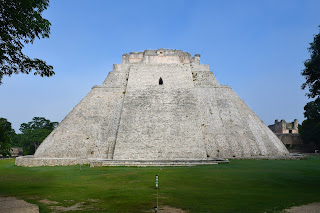The Yucatan Day 2
Anticipating a slightly delayed opening time, we arrived at the gates of Uxmal at 8:10. The early visit was a good idea, as during the hour we spent there, we saw fewer than a dozen people (and half of them were employees of the site). Much of what can be seen at Uxmal today was built throughout the ninth and tenth centuries, during the Late Classic Maya period, but the city was allegedly founded over three hundred years earlier. Legend has it that the main pyramid (or the “Adivino”) was built by the mythical Dwarf King overnight.
Uxmal is often the first site visitors see on the so-called
Puuc Route, a road that connects several major Maya cities in the Puuc region
of southern Yucatán state. However, shortly after leaving Uxmal, we discovered
that the pyramid was the only Puuc site we would get to visit. The rest were
all closed to tourists and the upright guards were truly incorruptible. This
was, of course, quite a disappointment, not least because we stared death in
the face while driving down the narrow jungle road. My dad had me stay alert so
I could watch for incoming traffic when turning leftwards, while he kept his
eyes peeled for cars coming from the right. We had several close brushes with
trucks coming from the opposite direction.
Relatedly, on our way from Uxmal to Kabah, two animals
crossed the road and having decided they were too big for coatis and too
slender for dogs, we agreed they might have been jaguar cubs. I don’t think
this theory is very far-fetched, as we saw several signs alerting us to the
possibility of jaguar encounters on our journey.
With a quickly diminishing gas tank, we made a short detour
to the town of Oxkutzcab, where not much of import happened besides the
necessary refuelling. Our northward journey continued, and we reached our next stop,
Mayapan, shortly after 11 AM. Among all the lesser-known Maya sites of the
Yucatan, I feel Mayapan is the most underrated: none of our three guidebooks
dedicated more than two sentences to the ancient city and its addition to our
list was a bit of an afterthought. I only included it after coming across it on
a list of things to do in Merida, when its name rang a bell somewhere in my
ancient Mesoamerican documentaries compartment. Relative obscurity does have its
upsides though: the place was practically deserted, which lent it a uniquely
tranquil atmosphere.
Mayapan became the leading city in the Yucatan after the
fall of Chichén Itzá at the beginning of the thirteenth century. It brought
together a number of noble families from subsidiary cities under the leadership
of Hunac Ceel, who had led a revolt against the Toltec-ruled Chichén Itzá. By
the fifteenth century, however, the alliance between the noble Maya families
against Toltec outsiders fell apart and the Yucatan devolved into many antagonistic
city states.
Due to a number of Puuc sites being closed, we found
ourselves arriving at and leaving Mayapan much earlier than we expected.
Therefore, instead of heading back to Valladolid, we decided to visit a few
more sites in the vicinity of Mérida. The first on our list was Dzibilchaltún,
a Maya site famous for its so-called “Temple of Seven Dolls”. My expectation
was that since Dzibilchaltún had several thousand reviews on Google, it would
not be closed due to the pandemic. Pandemic closures only seemed to affect less
visited sites, while the most popular attractions (like Chichén Itzá, Ek-Balam,
and Uxmal) remained open.
This calculation proved correct but unhelpful. Rather than
finding it closed because of the pandemic, we found Dzibilchaltún closed
because of a strike. As the man at the closed gate alleged, the owners of the
access road were not receiving their promised pay from the government.
Once again, we lost very little time at an attraction we had
intended to tour, giving us a chance to visit even more far-fetched locations.
We decided to drive another hour northeast, making a stop at the seaside
archaeological site Xcambó. The ancient Maya port, which presumably also
doubled as a salt-making hub (as the neighbourhood does to this day), is
currently known for a tiny church built on its ruins, as well as a wooden cross
erected on top of the main pyramid. They give off the impression that the early
colonists made a hasty effort to Christianise the area but were bested by its fast
decline.
The last stop on our trip was Valladolid, a town with a
bloody history of colonial oppression and violent uprise. Rather ill-advisedly,
I planned our trip to be a walking tour, which began at the Cathedral of Saint
Servatius (San Servacio) in the city centre, went south to the Church of San
Juan, then west to the Monastery of Saint Bernardino of Siena, and back
northeast to the city centre via the Calzada de los Frailes, a picturesque
street full of restaurants and hotels. I had based this plan on our experience
in Mérida, where parking places, especially near historical areas, were sparse.
I also thought it would be nice to go on a leisurely walk through what was
purportedly the city centre.
Perhaps this plan would have made sense had tiny Valladolid
been comparable in any way to the one-million people strong Mérida. Almost as
soon as we left the main square, we entered some not very picturesque parts of
Valladolid, with which we became intimately acquainted by the time we
resurfaced at the monastery. The monastery was nice enough, though I imagine
that back in the day it was thought of as being outside the city, which would
explain the suburban trek one has to undertake to get there.





























































Comments
Post a Comment